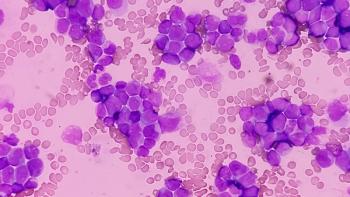
Chemoimmunotherapy Combinations Shift Stage IV Nonsquamous NSCLC Treatment Paradigm
New study results show that chemoimmunotherapy combination options provide an overall survival benefit to patients with stage IV nonsquamous NSCLC.
The emergence of chemoimmunotherapy combinations in the stage IV nonsquamous non—small cell lung cancer (NSCLC) paradigm has resulted in clear survival gains for patients, regardless of PD-L1 expression, said Hossein Borghaei, DO, MS.
Future research, he added, will focus on optimal approaches for patients who progress on these frontline regimens and identifying biomarkers of response.
“Several [chemoimmunotherapy] trials have had a huge impact on how we treat this disease and many of them have changed the standard of care for our patients,” said Borghaei, a professor and chief of thoracic oncology at Fox Chase Cancer Center.
One such pivotal study was the phase III KEYNOTE-189 trial, which demonstrated the safety and efficacy of frontline pembrolizumab (Keytruda) plus pemetrexed (Alimta) and either carboplatin or cisplatin in patients without EGFR or ALK alterations. Specifically, the combination led to a median overall survival (OS) of 22.0 months compared with 10.7 months with chemotherapy alone (HR, 0.56; 95% CI, 0.45-0.70; P <.00001).1
In an interview with OncLive®, a sister publication to Oncology Nursing News®, Borghaei highlighted pivotal trials examining the use of chemoimmunotherapy in metastatic nonsquamous NSCLC, ongoing research efforts, and exciting biomarkers on the horizon.
OncLive: Could you discuss the research with chemoimmunotherapy in metastatic nonsquamous NSCLC?
Borghaei: [There are] several large phase III studies, all of which basically randomized patients to receive either chemotherapy plus a checkpoint inhibitor versus chemotherapy, which was the standard of care when all of these trials were designed. The take-home message is that almost universally, these trials confirmed the superiority of chemotherapy plus immunotherapy in patients with metastatic nonsquamous NSCLC, regardless of PD-L1 expression.
PD-L1 levels were checked because that is a biomarker that we're all interested in, but it doesn't appear that PD-L1 selection is quite as important when it comes to chemoimmunotherapy combinations. The data clearly show that progression-free survival (PFS) is better for patients who have any level of PD-L1 expression, meaning that PD-L1—negative patients did not have as much of a PFS benefit with chemoimmunotherapy. However, OS does seem to favor the use of the combinatorial approach.
The magnitude of benefit is larger and better in some studies, for instance in the KEYNOTE-189 trial with the combination of platinum-based therapy plus pemetrexed and pembrolizumab. Nonetheless, I believe the majority of the trials support the use of chemotherapy combinations with checkpoint inhibitors.
Could you expand on the significance of the KEYNOTE-189 trial?
KEYNOTE-189 is a phase III randomized study of patients with nonsquamous NSCLC, regardless of PD-L1 expression. Patients who were eligible for the study did not have EGFR mutations, ALK translocations, or molecularly driven tumors in general. Randomization was simple: chemotherapy, with what we would consider to be carboplatin and pemetrexed, alone or combined with pembrolizumab.
If you look at OS and PFS by level of PD-L1 expression, you see that survival favored the use of the combination, regardless of PD-L1 level. However, PFS was better in patients who had any level of PD-L1 expression. Those data established this combination as one of the standards. I would favor the use of pemetrexed for patients with nonsquamous histology, as long as they meet all of the required criteria; this includes adequate renal function and everything else that allows them to be treated with pemetrexed.
The regimen is usually well tolerated; there's clearly more toxicity when you add pembrolizumab to a backbone of chemotherapy, but the toxicities, by and large, were manageable. Notably, there was a slightly higher rate of renal issues with the use of pembrolizumab in combination with pemetrexed and carboplatin. As such, [this combination] does require a little bit more vigilance in terms of following the renal functions in these patients.
Interestingly, the immune-related adverse events were not found to be significantly worse with the addition of pembrolizumab to chemotherapy, which was something nice to see. We were happy with the results of the study. For patients who do not have molecular drivers, who are not clinical drug candidates, or don't want to be enrolled in a clinical trial, a combination of carboplatin, pemetrexed, and pembrolizumab seems to be a very reasonable option.
Where are research efforts being focused in this space?
The final results of CheckMate-227 [were presented at the 2019 ESMO Congress]. This study looked at a chemotherapy-sparing regimen, the combination of ipilimumab and nivolumab. It is possible that because the trial [was] positive, our patients [may] have an option of using a double immunotherapy combination instead of receiving chemotherapy plus or minus immunotherapy as their treatment.
It’s important to remember that the majority of these patients are not being cured, so there's still a lot of work to be done. For instance, one of the major areas that we're all concentrating on right now is what to do for patients who have had chemoimmunotherapy or doublet immunotherapy upfront, and then progress? What do we do for those patients? Clearly, if they haven't had any chemotherapy upfront, the next line of therapy could be chemotherapy.
However, is that really an appropriate way of treating them? What are going to be the responses in that category and what are the potential toxicities? These are areas of active research, and there is a lot of interest in developing other checkpoint inhibitors or other immunotherapy mechanisms to assess clinical efficacy in a patient population that has had both chemotherapy and immunotherapy. If any of those [efforts] show promise, then I believe there would be an interest in moving those compounds or regimens into the frontline setting, so that we can improve the survival of patients [earlier].
The key thing to remember is that, unfortunately, many of our patients with lung cancer never see second- or third-line therapies. Therefore, it is imperative for us to find drugs that work and move [them] to the frontline setting where we can capture almost 100% of our patients, as opposed to waiting for the second- or third-line setting. However, the way drug development works is that we usually start with the refractory patient population and whatever works, we try to move into the frontline space.
What are some emerging biomarkers in the space to be aware of?
My hat goes off to those who are working on biomarker research; it's a very, very difficult area. We all know about PD-L1. Tumor mutational burden (TMB) has also received a lot of attention. Whether that attention is justified or not, I believe TMB is a biomarker that we still are playing within the clinic, and we’re trying to see if we can identify specific patient populations. There is blood-based TMB, tissue-based TMB, and a couple of different platforms that are being investigated and looked at.
Beyond that, other T-cell activation markers have been looked at as potential predictors of response to immunotherapy; there's an interferon-gamma [messenger RNA] signature that we are going back and forth with. Some [research] groups are also looking at composites; for instance, PD-L1 expression and infiltrating lymphocytes. We can divide tumors into several different categories based on the level of T-cell infiltration and PD-L1 expression. The biomarkers that I believe are even more interesting are those that are very drug-specific. For instance, some combinations out there have been investigated, and in a retrospective manner, it appears that certain lymphocyte populations may be predictive of response or lack thereof. The problem is that these [conclusions] are bit disjointed; they are based on small studies. It’s hard to bring this knowledge into the general patient population without more work.
A version of this article originally appeared on OncLive® as, “
References
- Gadgeel SM, Garassino MC, Esteban E, et al. KEYNOTE-189: updated OS and progression after the next line of therapy (PFS2) with pembrolizumab (pembro) plus chemo with pemetrexed and platinum vs placebo plus chemo for metastatic nonsquamous NSCLC. J Clin Oncol. 2019;37(15 suppl; abstr 9013). doi: 10.1200/JCO.2019.37.15_suppl.9013.
Newsletter
Knowledge is power. Don’t miss the most recent breakthroughs in cancer care.
















































































